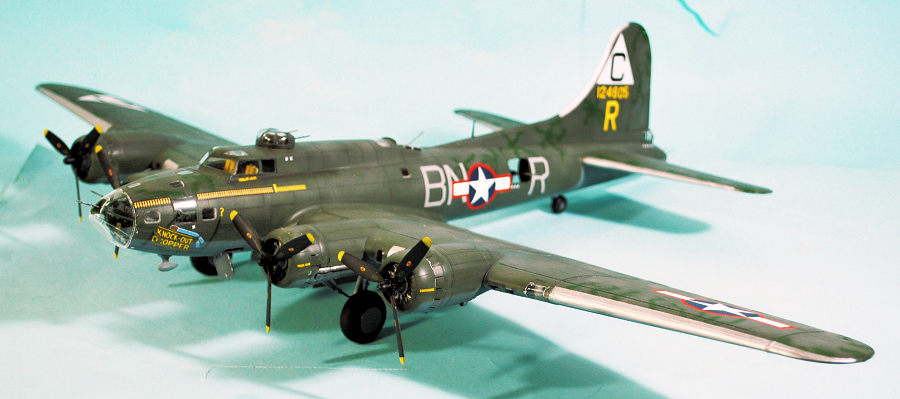
HK Models 1/48 B-17F Flying Fortress
| KIT #: | 01F002 |
| PRICE: | $120.00 or so |
| DECALS: | Two options |
| REVIEWER: | Tom Cleaver |
| NOTES: | Kits World Decals KW148130 |

| HISTORY |
The B-17 Flying Fortress is the most iconic symbol of American air power of World War II. In a 1943 Consolidated Aircraft poll of 2,500 men in cities where Consolidated advertisements had been run in newspapers, 73 percent had heard of the B-24 and 90 percent knew of the B-17. People who know nothing else about World War II aviation today know of the B-17.
While models A through D of the B-17 were designed defensively, the large-tailed B-17E was the first model primarily focused on offensive warfare, with an extensive revision of the Model 299 design in which the fuselage was extended by 10 ft; a much larger rear fuselage, vertical tail fin, rudder, and horizontal stabilizer were added, with a gunner's position added in the new tail; the nose in the B-17E remained relatively the same as the earlier B through D versions had, but was changed to a clear nose cap in the F and G models; a Sperry electrically powered manned dorsal gun turret just behind the cockpit was added; a similarly powered Sperry manned ventral ball turret was just aft of the bomb bay. These modifications resulted in a 20 percent increase in aircraft weight. The turbocharged Wright R-1820 Cyclone engines were upgraded to more powerful versions.
The B-17F was the main version flying with the Eighth Air Force from the fall of 1942 to the fall of 1943 when the first B-17Gs arrived. A total 3,405 B-17Fs were produced, primarily by Boeing with Douglas and then finally Lockheed-Vega contributing to production.
The 303rd Bomb Group:
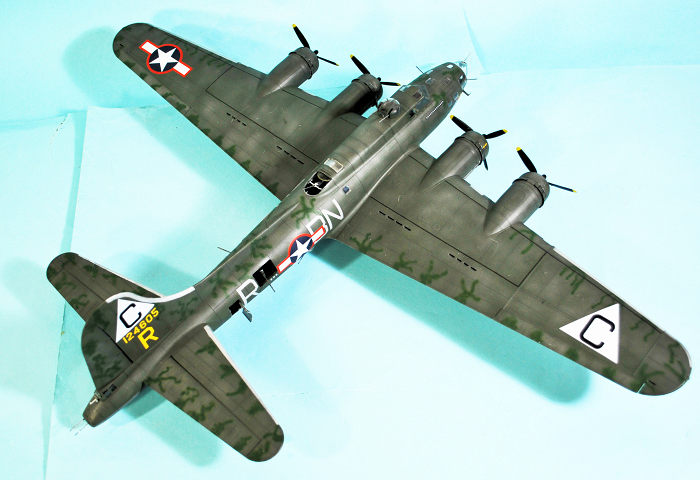 The
303rd Bombardment Group (H) “stood up” on January 28, 1942 at Savannah, GA, then
moved to Pendleton Field, Oregon on February 3, 1942. Training for combat
missions took place at Alamogordo Air Base, New Mexico, and Biggs Field, Texas.
On August 23, 1942, the ground echelon moved to Fort Dix, New Jersey, to board
the Queen Mary for overseas deployment. They arrived at Molesworth, England, on
September 9, followed by the air echelon’s arrival in late October.
The
303rd Bombardment Group (H) “stood up” on January 28, 1942 at Savannah, GA, then
moved to Pendleton Field, Oregon on February 3, 1942. Training for combat
missions took place at Alamogordo Air Base, New Mexico, and Biggs Field, Texas.
On August 23, 1942, the ground echelon moved to Fort Dix, New Jersey, to board
the Queen Mary for overseas deployment. They arrived at Molesworth, England, on
September 9, followed by the air echelon’s arrival in late October.
The 303rd’s first combat mission was flown on November 17, 1942, with a planned strike at the St. Nazaire submarine pens, but weather obscured the target, resulting in a return to base, the first of 363 missions to come.
First targets were in France and the Low Countries. Several targets in Paris were struck in 1943 and, although the city was defended by about 250 flak guns, only one plane was lost in six attacks. The 303rd’s formations often encountered the "Abbeville Kids" of JG 26. Unlike groups such as “The Bloody Hundredth,” the 303rd was a “lucky” group when it came to losses, but this was not so much luck as the fact they were the first group to adopt the staggered “Combat Box” formation providing mutual defensive support that Luftwaffe attackers compared with attacking a porcupine.
Once the campaign extended to Germany targets like Mannheim and Ludwigshafen were attacked 12 times with only five losses. The transport and industrial center of Frankfurt was bombed nine times in 1943 and 1944, during which only three aircraft were lost. The August 15, 1944 attack on the Wiesbaden airfield cost the group nine bombers. Cologne rail lines and industry were the targets on 10 missions. The largest marshalling yard in Germany, located at Hamm, was hit six times and its flak defenses accounted for two aircraft down.
After the B-17 “Hell’s Angels” became the first to survive 25 missions in March 1943, the group took the airplane’s name as its own after the Air Force refused to send the airplane and its crew home for the promised tour on grounds the airplane’s name was sure to offend the Professionally Easily Offended back home.
On January 11, 1944, leading the First Division, the 303rd hit Oschersleben, Germany, after most of the 8th Air Force and its fighter escort had aborted due to weather. The devastating strike cost 10 aircraft (42 altogether in the First Division). For this valuable contribution to the war effort, the Hell's Angels Group, was awarded a Distinguished Unit Citation.
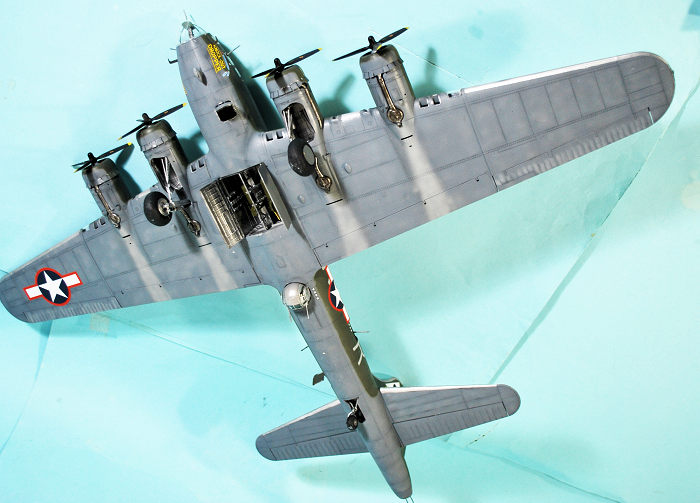 On March 6,
1944, the Group participated in the first major strike on Berlin. On D-Day, June
6, 1944, the group flew three separate missions between dawn and
dusk in a ground support role rather than a strategic bombing force. When the
303rd “Hell's Angels” Bomb Group was deactivated in Casablanca on 26 July 1945,
its record "firsts" included:
On March 6,
1944, the Group participated in the first major strike on Berlin. On D-Day, June
6, 1944, the group flew three separate missions between dawn and
dusk in a ground support role rather than a strategic bombing force. When the
303rd “Hell's Angels” Bomb Group was deactivated in Casablanca on 26 July 1945,
its record "firsts" included:
“Knockout Dropper,” the first B-17 to complete 50 Eighth AF combat missions - on the anniversary of the group’s first mission - in tight competition with “S for Sugar” and “Hell's Angels,” which totalled 75 missions two missions later. “Knockout Dropper,” first B-17 to complete 75 Eighth AF combat missions. First Eighth AF Bombardment Group to complete 300 missions from bases in England. Two combat crewmen were awarded the Medal of Honor while four were awarded the Distinguished Service Cross Medal
An Eighth Air Force combat score of:
364 combat missions - the most flown by any B-17 Bomb Group. 10,721 aircraft sorties flown - the second highest in the Eighth Air Force. 26,346 tons of bombs dropped - the second highest in the Eighth Air Force. 378 enemy aircraft destroyed - the third highest in the Eighth Air Force (these claims were all fantasy, but were allowed for morale purposes)
The first Medal of Honor awarded in the ETO went to a 359th Bomb Squadron bombardier, 1st Lieutenant Jack Mathis, who died over his bombsight in the “The Duchess" after dropping his bombs on Vegasack. As squadron lead bombardier his sacrifice allowed the Eighth Air Force do its first real precision bombing. Of 14 B-17 crewmen of the Eighth awarded the Medal of Honor, 11 were posthumous.
“Knockout Dropper”:
The first B-17 in the Eighth Air Force to complete 50 missions on November 17, 1943, and the first to complete 75 missions on March 27, 1944, B-17F-20-BO 41-24605 “Knockout Dropper” completed 80 missions by the time she left the ETO on April 7, 1944 for a War Bond tour in the United States.
| THE KIT |
The Revell B-17F has remained unchallenged in 1/48 since it first appeared in the late 1970s. Over the years, modelers have wondered if anyone would ever produce a new kit up to modern standards. H-K Models has answered that question in the affirmative, with this scale-down of their 1/32 B-17E/F kit.
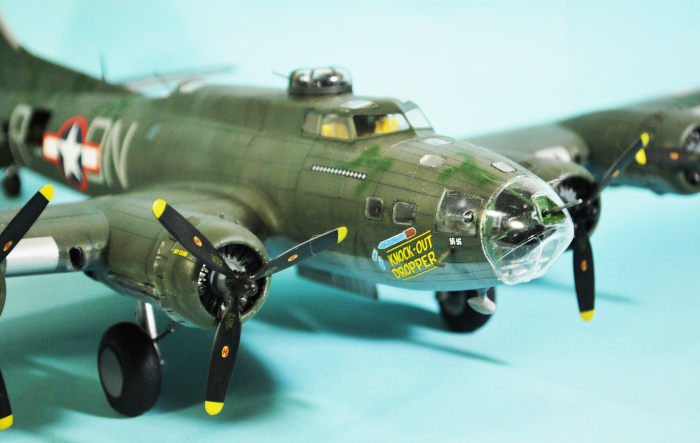 This new
kit has the same production quality as the earlier model. Surface detailing is
similar in quality to that of the recently-released Eduard P-51D. Interior
detail is simplified in comparison to the earlier kit, but the fact is that
there is little interior to be seen in the B-17 once the fuselage is closed up,
and what is provided is more than adequate. The Professional Complainers who
were upset that the nose of the 1/32 kit wasn’t properly “flattened” on top
ahead of the cockpit will be pleased to note that this area has been changed in
this kit.
This new
kit has the same production quality as the earlier model. Surface detailing is
similar in quality to that of the recently-released Eduard P-51D. Interior
detail is simplified in comparison to the earlier kit, but the fact is that
there is little interior to be seen in the B-17 once the fuselage is closed up,
and what is provided is more than adequate. The Professional Complainers who
were upset that the nose of the 1/32 kit wasn’t properly “flattened” on top
ahead of the cockpit will be pleased to note that this area has been changed in
this kit.
From what is on the sprues, particularly the clear sprue that has all three different dorsal turrets, it is clear there will be a future release of a B-17E.
The kit provides decals to do the well-known “Memphis Bell” and another B-17F “All American.” Kits World Decals does a number of different B-17F sheets that are easily avaiable, and there are other sheets that were produced such as one by Super Scale for “Hell’s Angels,” the first B-17 to make it to 25 missions (before Memphis Bell, but the USAAF thought the name was “NSFW”) that can be found on eBay.
| CONSTRUCTION |
I began by painting all the interior parts before taking them off the sprues. I didn’t go into a lot of detail in making the wood floors since they can’t be seen, and painted them with Tamiya XF-69 NATO Black, since many B-17Fs had non-skid on the wooden floors.
I find that attaching the nose and tail pieces to the main fuselage before proceeding further allows a better fit – I had to do some bending of the nose parts to get them to match up with the main fuselage, and that is more easily done at this stage.
The first
thing to do is cut off all the ejection towers. Yeah, it’s a pain and you need
to sand down the mating surface to be sure it’s totally clear, but doing these
this way, there aren’t any nasty things to fill in on the part,
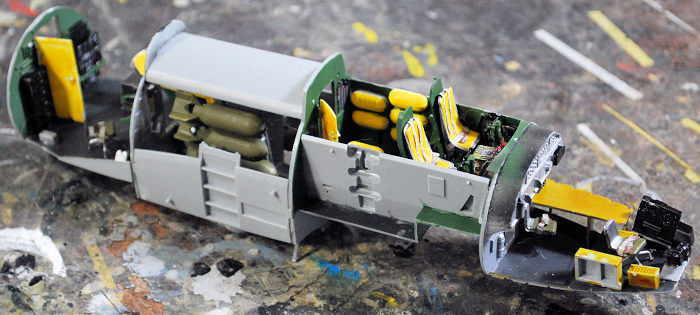 so that’s good.
I also took time to scrape down the edges of the bulkheads a bit. The kit has
very tight fit, and doing this will allow you to get the fuselage halves
together without a lot of industrial-strength pushing and shoving to bring
everything together.
so that’s good.
I also took time to scrape down the edges of the bulkheads a bit. The kit has
very tight fit, and doing this will allow you to get the fuselage halves
together without a lot of industrial-strength pushing and shoving to bring
everything together.
The fuselage interior on B-17s was unpainted aluminum if the padding was stripped off, other than the cockpit, which was Dull Dark Green. I chose to do this model with the aluminum interior to make things as bright as possible in hopes of seeing things better. I painted the interior with Tamiya X-18 Semi-gloss Black, and then Vallejo Aluminum. The Cockpit parts were painted with Tamiya XF- , Deep Green.
I opened the doors between compartments. With the open rear hatch and open forward hatch, and open bomb bay, I hoped there would be enough light gets inside the fuselage to actually see things. I used the Eduard photoetch detail set, mostly instrument panel faces that can’t be seen once it’s closed up, other than the radio compartment, where I positioned the hatch slid open; you can also notice seatbelts in the cockpit. Even with the doors opened up the light isn’t that much inside, not to mention it’s all closed up. As it turned out, all that effort was a fool’s errand, but you can see shapes that tell you something’s in there.
I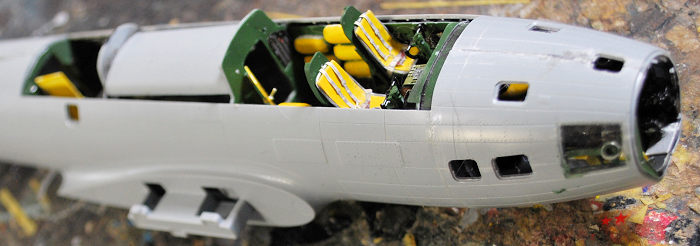 glued the
cheek guns in position so they could be inside the fuselage, with their gun
barrels attached at the end of the project.
glued the
cheek guns in position so they could be inside the fuselage, with their gun
barrels attached at the end of the project.
The wings presented no problem in assembly. It is possible to assemble the main landing gear after you have painted the model, but it is far easier to assemble those parts at this point in the assembly. The good news for modelers with restricted display space is that the wings do not have to be glued to the fuselage, and can be removed. The attachment is quite tight and even if you don’t intend to remove the wings for storage, you don’t need to glue the wings. I was quite happy to be able to keep the wings off while painting the model.
Engines and cowlings can’t be glued in position until after painting since you have to install the turbo exhausts first, so they fit under the cowling flaps.
| COLORS & MARKINGS |
The gear legs and wheel hubs were painted with Vallejo “Dull Aluminum” after being primed with Tamiya X-18 “Semi-gloss Black,” which was also used on the propellers. The Ball Turret was painted with Vallejo “Dull Aluminum.”
First, I preshaded on panel lines, then applied the basic “factory-fresh” paint scheme. I used Tamiya XF-53 Neutral Grey for the lower surfaces and Tamiya XF-74 “OD (JGSDF)” mixed with some Tamiya XF-51 “Khaki Drab” for the green-base OD-41, as I think this is a close match if you compare it with the nice well-lit color photo of the factory-fresh B-17 included here.
Once I had
the basic upper color on, I added a little more XF-51 Khaki Drab, and thinned
the mixture some more. I went back over the various panels. I wanted just enough
difference in color to emphasize the panel lines in the original color. Then I
went over it three times, each time adding more XF-51 to the XF-74, and thinning
it as a wash. I blotched it over the airframe, concentrating the lighter colors
on the upper-facing surfa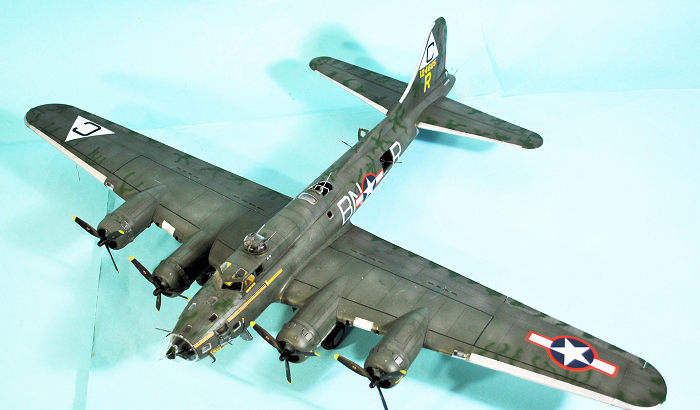 ces. After the third pass, I added in some Violet,
thinned again and went over it, then more Violet and thinner, concentrated on
the upper surfaces. This is to emphasize UV-sun fading, since these airplanes
did their fading in the ETO primarily at altitude, with strong UV light. I then
added in a bit of XF-78 “Wood Tan” and went over the fabric control surfaces,
since they faded differently than the metal surfaces.
ces. After the third pass, I added in some Violet,
thinned again and went over it, then more Violet and thinner, concentrated on
the upper surfaces. This is to emphasize UV-sun fading, since these airplanes
did their fading in the ETO primarily at altitude, with strong UV light. I then
added in a bit of XF-78 “Wood Tan” and went over the fabric control surfaces,
since they faded differently than the metal surfaces.
When all that was done, I cleaned the brush and painted the Medium Green blotches with XF-5 Flat Green, a good match for US Medium Green. I used a jpeg of the boxart of the Hasegawa limited release of “Knockout Dropper” to see the blotch patterns.
I unmasked the leading edges where the de-icer boots had been but had been removed – there aren’t a lot of photos of the entire airplane, so it is unclear if the de-icer boots had been removed before or after Mission #50. I went with removal because it looks better. These areas had been painted with Tamiya XF-16 Flat Aluminum before masking. Once the masks were removed, I went over the area with brush-painted Vallejo Aluminum.
I used the Kits World decals for “Knockout Dropper,” and Fundekals for the National Insignia.
I applied several coats of clear flat to get the model dulled down. I then painted the turbo exhausts using Tamiya XF-19 “Sky Grey”, then went over the engine nacelles and the wing immediately behind them with Tamiya “smoke” to simulate oil. DO NOT put exhaust coming out of the four ports on the upper wing behind the nacelles. THEY WERE NOT EXHAUST PORTS.
I attached the gun barrels, installed the upper and lower turret and the waist guns, attached the bomb bay doors, rear door and lower front hatch, and attached the props - which do not have to be glued, allowing you to remove then if you take off the wings to store or transport the model.
| CONCLUSIONS |
Overall, the model is complex but not complicated. There are a couple of “off” issues in shape, but only those at The Central Office of Those Who Will Never Be Satisfied need to really worry. Yes, I like accuracy, but I can live with some inaccuracy that doesn’t hit me in the eye, if lots of other things are good – which is the case here. Given that the alternative in 1/48 is the Revell kit if you can find it, which has no interior, and for which the resin interior created by True Details for Sqquadron is no longer available, and incorrect turrets, the H-K B-17F is definitely the winner here.
Tom
Cleaver 18 March
2021 Copyright ModelingMadness.com. All rights reserved.
Thanks to
my friend Neil Yan at H-K Models for the review kit. If you would like your product reviewed fairly and fairly quickly, please contact the editor or see other details in the
Note to
Contributors.